Комета ISON, которой астрономы предрекали звание самой яркой кометы первой половины XXI века, не перенесла сближения с Солнцем. Согласно последним новостям, "«хвостатая не перенесла пролета через перигелий. До последнего момента она вела себя непредсказуемо – то вспыхивая, то угасая, но в итоге, как передает NASA, комета распалась и погибла, хотя некоторые астрономы до конца в этом не уверены. Они утверждают, что ядро кометы распалось не позднее полудня пятницы, но слабоконтрастный хвост можно будет наблюдать на небе весь декабрь. На фото и особенно видеозаписях кометы, смонтированных различными телескопами, видно, как комета распадается при подлете к Солнцу.
Комета ISON испарилась после сближения с Cолнцем. На сайте NASA (Космическое агентство США) опубликована информация об исчезающем гигантском шаре изо льда и пыли. Астрономы не теряли надежду и продолжали наблюдение, однако в итоге стало ясно, что комета не выдержала столь близкого соседства с Солнцем.
28 ноября ISON должна была подойти к Солнцу на расстояние около 1 млн км, это в 150 раз ближе, чем расстояние от самого большого небесного светила до Земли. Это считается максимально близким расстоянием, на которое любое небесное светило может подлететь к Солнцу без опасности быть уничтоженным. Если на минуточку представить другое развитие событий — то, что комета ISON 28 ноября успешно бы прошла перигелий (ближайшая к Солнцу точка орбиты), то в следующий раз жители Земли увидели бы ее только через 2 млн лет.
Комета ISON сегодня уже не существует. Она не выдержала жара Солнца и испарилась, оставив после себя «слабое облачко». Еще до подлета к Солнцу на минимальное расстояние (1,16 млн километров) ядро кометы разрушилось. От него осталось лишь облако пыли. Впрочем, астрономы не унывают из-за преждевременной «смерти» кометы: «При ее распаде высвободились вещества, из которых она состояла, и мы можем узнать больше о той материи, из которой образовалась Солнечная система», — заявил астроном и популярный блогер Фил Плэйт в ходе телеконференции НАСА.
Фото кометы ISON опубликованы на сайте NASA. Там видно, что осталось от кометы после сближения с Солнцем. Тысячи астрономов по всему миру наблюдали за кометой. У кометы, если бы она не разрушилась, был потенциал засиять в полную силу и даже затмить по яркости Луну.
-
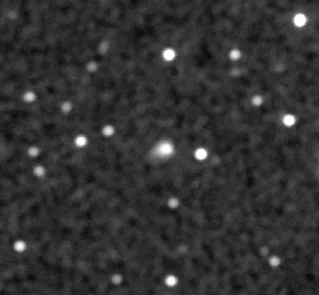
The Ultraviolet/Optical Telescope aboard NASA's Swift imaged Comet ISON (center) on Jan. 30, when it was located about 3.3 degrees from the bright star Castor in the constellation Gemini. At the time of this 5.5-minute optical exposure, ISON was about 5,000 times fainter than the limit of human vision and was located 375 million miles (604 million km) from Earth and 460 million miles (740 million km) from the sun. Credit: NASA/Swift/D. Bodewits, UMCP
-
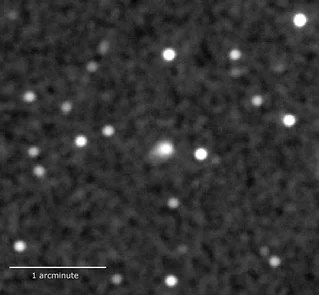
The Ultraviolet/Optical Telescope aboard NASA's Swift imaged Comet ISON (center) on Jan. 30, when it was located about 3.3 degrees from the bright star Castor in the constellation Gemini. At the time of this 5.5-minute optical exposure, ISON was about 5,000 times fainter than the limit of human vision and was located 375 million miles (604 million km) from Earth and 460 million miles (740 million km) from the sun. Credit: NASA/Swift/D. Bodewits, UMCP
-
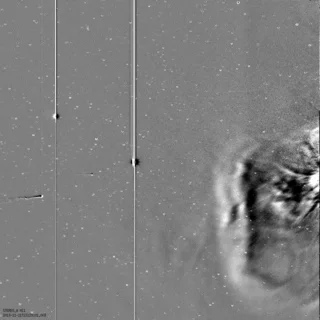
This still image from the video shows comet ISON just passing the plane of Mercury, with Comet Encke ahead and slightly above on Nov. 22, 2013. The sun is off-screen to the right. The wave-like shape on the right is a coronal mass ejection (CME.) Image Credit:Karl Battams/NRL/NASA STEREO/CIOC
-
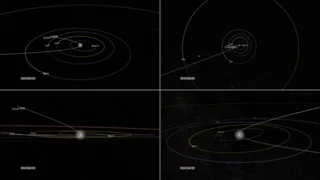
Still of all four views of ISON orbital path.
-
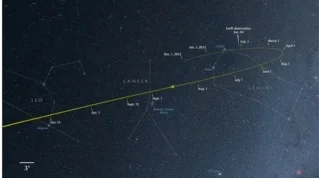
From now through October, Comet ISON tracks through the constellations Gemini, Cancer and Leo as it falls toward the sun. Credit: NASA's Goddard Space Flight Center/Axel Mellinger, Central Michigan Univ.
-
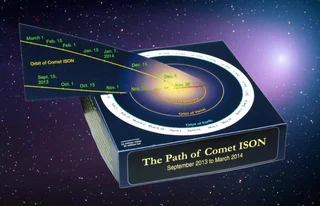
This paper model illustrates the comet's path during its six-month trek in the vicinity of Earth, Venus and Mercury. Track how the relationship between Earth and the comet constantly changes by referring to the dates along both orbits.
-

Comet ISON is now approaching the inner solar system. Discovered last year, the comet remains unusually active for its distance from the sun. If current trends continue, ISON could rank as one of the brightest comets in decades when it makes its close approach to the sun in late November. This animation shows the comet's approach and departure from the inner solar system from various perspectives. Credit: NASA's Goddard Space Flight Center Scientific Visualization Studio
-
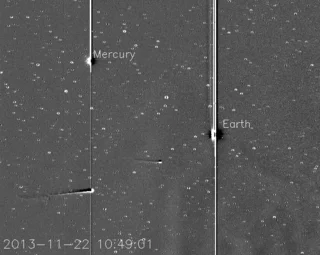
NASA's STEREO-A spacecraft is monitoring Comet ISON as it approaches the sun. The latest movie from the spacecraft's Heliospheric Imager shows Comet ISON, Mercury, Comet Encke and Earth over a two day period from Nov. 20 to Nov. 22, 2013. The sun sits right of the field of view of this camera. Image Credit: Karl Battams/NRL/NASA STEREO/CIOC.
-
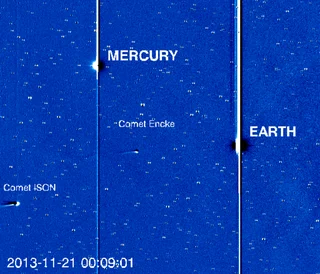
Comet ISON makes its appearance into the higher-resolution HI-1 camera on the STEREO-A spacecraft. The dark "clouds" coming from the right are density enhancements in the solar wind, causing all the ripples in comet Encke's tail. These kinds of solar wind interactions give us valuable information about solar wind conditions near the sun. Note: the STEREO-A spacecraft is currently located on the other side of the Sun, so it sees a totally different geometry to what we see from Earth. Credit: Karl Battams/NASA/STEREO/CIOC
-
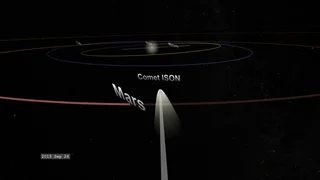
This animation shows two views of comet ISON's path through the inner solar system. The first is a view following the comet along its orbit. The second is a view perpendicular to ISON's orbit. Credit: NASA's Goddard Space Flight Center Scientific Visualization Studio
-
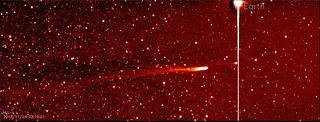
Cropped and enlarged footage from the STEREO A Hi 1 sensor covering Nov 21 at 0:39UT to Nov 25 at 15:19 UT.The sun sits right of the field of view of this camera. Credit: Nathan Rich/NRL/NASA STEREO/CIOC.
-
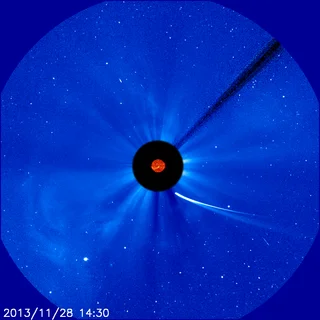
Comet ISON moves ever closer to the sun in this image from ESA and NASA's Solar and Heliospheric Observatory, or SOHO, captured at 9:30 a.m. EST on Nov. 28, 2013. This image is a composite, with the sun imaged by NASA's Solar Dynamics Observatory, or SDO, in the center, and SOHO showing the solar atmosphere, the corona. Credit: ESA
-
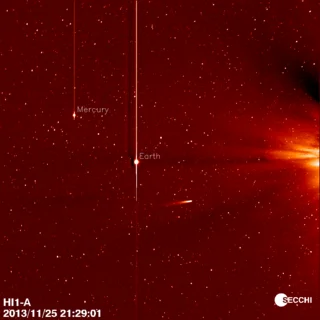
NASA's STEREO-A spacecraft continues to observe Comet ISON as it approaches the sun. This movie from the spacecraft's Heliospheric Imager shows Comet ISON, Mercury, Comet Encke and Earth over a five day period from Nov. 20 to Nov. 25, 2013. The sun sits right of the field of view of this camera. This is the full-resolution, full field-of-view. It covers the same time period as the video above and has a time stamp. Credit: NRL/NASA STEREO/CIOC.
-
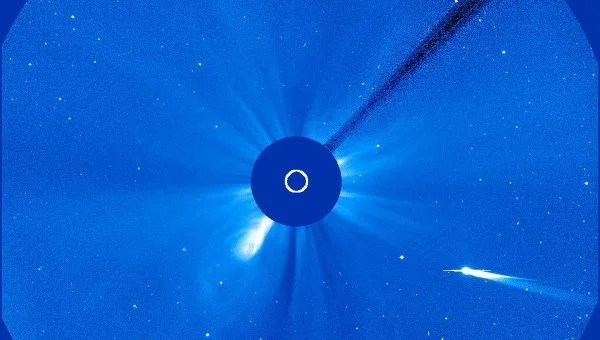
Comet ISON moves ever closer to the sun in this image from ESA and NASA's Solar and Heliospheric Observatory, or SOHO, captured at 9:30 a.m. EST on Nov. 28, 2013. This image is a composite, with the sun imaged by NASA's Solar Dynamics Observatory, or SDO, in the center, and SOHO showing the solar atmosphere, the corona. Credit: ESA
-
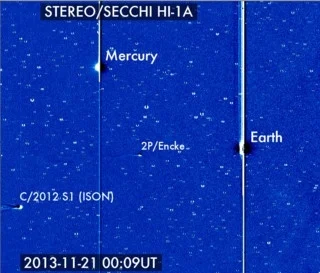
Comet C/2012 S1 (ISON) has entered the NASA STEREO/SECCHI HI-1A field of view where it joins the Earth, Mercury and comet 2P/Encke. Credit: Karl Battams/NASA/STEREO/CIOC
-
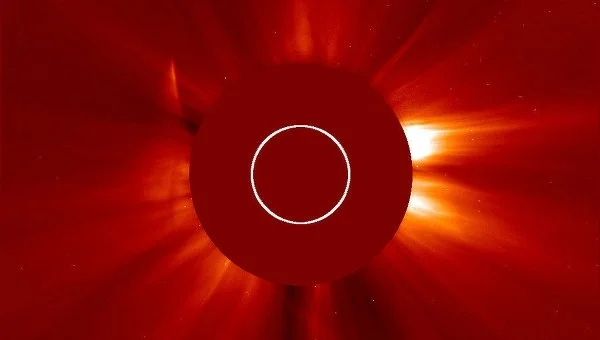
These images from NASA's Solar Terrestrial Relations Observatory and the ESA/NASA Solar and Heliospheric Observatory show Comet ISON growing dim as it made the journey around the sun. The comet is believed to have broken up and evaporated. Credit: NASA/SDO/ESA/SOHO/GSFC
-
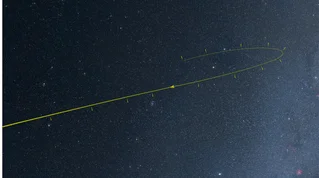
From now through October, Comet ISON tracks through the constellations Gemini, Cancer and Leo as it falls toward the sun. No Labels. Credit: NASA's Goddard Space Flight Center/Axel Mellinger, Central Michigan Univ.
-
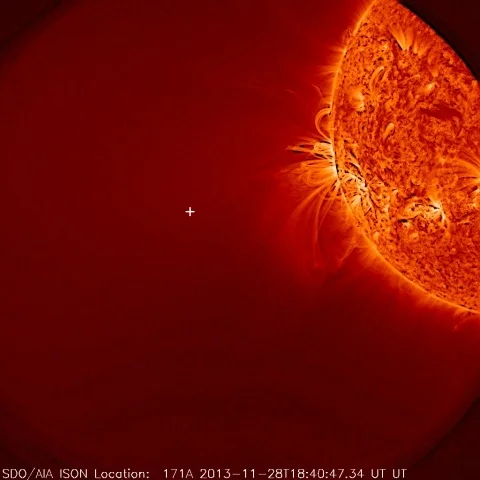
This image from NASA's Solar Dynamics Observatory shows the sun, but no Comet ISON was seen. A white plus sign shows where the Comet should have appeared. It is likely that the comet did not survive the trip. Image Credit: NASA/SDO
-
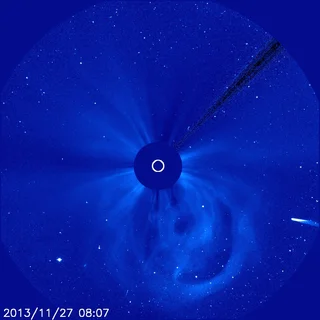
ISON enters the field of view of the joint ESA/NASA Solar and Heliospheric Observatory, or SOHO, spacecraft's C3 coronograph, where the brighter view of the sun itself is blocked to focus on the solar atmosphere, or corona. This video covers 17 hours beginning at 19:42 UT on Nov. 26, 2013. Full-resolution, full-field frames, video at 6fps and still. Credit: ESA
-
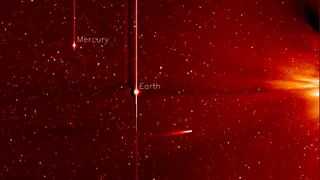
NASA's STEREO-A spacecraft continues to observe Comet ISON as it approaches the sun. This movie from the spacecraft's Heliospheric Imager shows Comet ISON, Mercury, Comet Encke and Earth over a five day period from Nov. 20 to Nov. 25, 2013. The sun sits right of the field of view of this camera. This version is enhanced, resized and cropped for HD. Credit: NASA/NRL/STEREO/CIOC/GSFC.
-
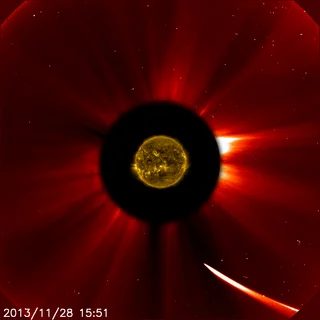
Comet ISON has moved quite close to the sun in this image from ESA/NASA's Solar and Heliospheric Observatory captured at 10:51 a.m. EST on Nov. 28, 2013. This image is a composite, with the sun imaged by NASA's Solar Dynamics Observatory in the center, and SOHO showing the solar atmosphere, the corona. Image Credit: ESA
-
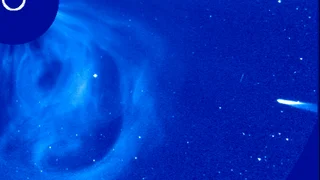
SON enters the field of view of the joint ESA/NASA Solar and Heliospheric Observatory, or SOHO, spacecraft's C3 coronograph, where the brighter view of the sun itself is blocked to focus on the solar atmosphere, or corona. This video covers 17 hours beginning at 19:42 UT on Nov. 26, 2013. Credit: ESA
Комета ISON была открыта астрономами-любителями: осенью 2012 года ее обнаружили россиянин Артем Новичонок из Петрозаводска и белорус Виталий Невский из Витебска с помощью 40-сантиметрового рефлектора телескопа обсерватории проекта ISON (международная небесная оптическая сеть) в Кисловодске (отсюда и название «хвостатой странницы»). В апреле 2013 года космический телескоп Hubble впервые сделал снимки ISON. На видео, смонтированном другой обсерваторией, кометы совсем не видно:

ИСТОЧНИК: NASA Goddard
На видеокадрах «хвостатой», смонтированных с помощью телескопов астрономами-любителями и блогерами, видно, как 28 ноября при подлете к Солнцу ISON теряет свою яркость, а вскоре вообще пропадает. Не оправдалась надежда, что комета «сохранит себе жизнь» и вылетит с другой стороны небесного светила. Гибель этой кометы не стала совсем уж уникальным событием: кометы меньшего размера сталкиваются с Солнцем регулярно.

ИСТОЧНИК: DauriaAerospace
Если судить по последним новостям о комете ISON, какую-то ее часть можно будет наблюдать на утреннем небе в декабре: «Ядро кометы окончательно развалилось, скорее всего, из-за Солнца вылетит уже шлейф обломков и пыли, — рассказал журналистам научный руководитель обсерватории «Ка-Дар» Станислав Короткий. — Яркого зрелища на утреннем небе в декабре ждать не стоит, но слабоконтрастный хвост может появиться».